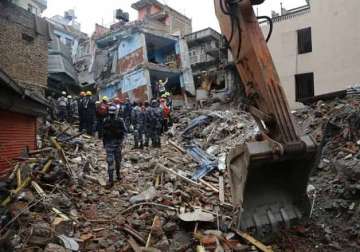Nepal quake toll nears 7,000; protests mount over slow relief
Kathmandu: Fresh tremors rocked parts of Nepal today, triggering landslides as the death toll in last Saturday's devastating earthquake neared 7,000 and protests mounted over relief not reaching several affected areas. A 5.1-magnitude aftershock shook

Kathmandu: Fresh tremors rocked parts of Nepal today, triggering landslides as the death toll in last Saturday's devastating earthquake neared 7,000 and protests mounted over relief not reaching several affected areas.
A 5.1-magnitude aftershock shook Barpak village in Gorkha district near the epicentre of the powerful 7.9-magnitude temblor that had caused widespread destruction. A woman was injured due to the tremor that was preceded by a 4.5-magnitude aftershock, triggering panic among the people.
The second aftershock also led to landslides, adding to the woes of the quake-hit people, many of whom have been forced to stay in the open.
A major landslide occurred at Dolalghat between Sindupalchowk and Kawre district here. “No injuries have been reported so far,” said a police official. The death toll in Nepal's worst quake in 80 years shot up to over 6,700 and another 14,025 people injured as the government struggled to deal with the massive scale of the disaster.
“The death toll has reached 6,624,” said the home ministry's national disaster management division but the figure is expected to go up further, with bodies still being pulled out from under mounds of debris in several areas including Miteripul, Chaku, Jhyalebhir, Nayapur, Daklang Paharo and Jhirpu.
Nepalese media said 16 bodies have been recovered along the Tatopani stretch of the Araniko Highway. Some foreigners are also believed to be buried in the landslides. The Home Ministry here feels that there is unlikelihood of any more survivors in the April 25 quake.
Angry people took to the streets alleging that relief material was finding its way to the black market and prices of essential items had also been steeply hiked. Many areas of the Kathmandu Valley are still deprived of necessary food items, which compelled people to resort to sloganeering against the authorities.
“A food item which is priced Rs 20 is now available for Rs 50. There is no transparency in the distribution of food and relief material,” said Nirmal Bishi, one of the protesters.
“They have just provided us with one bottle of water,” said Phulmaya Lagun, who has a family of 10 and homeless. Many parts still have not got tarpaulin sheets. “Only the influential gets the relief material, but what about others,” claimed Dawa Sherpa, who works as a daily wage worker and has been jobless after the quake.
“It will be a miracle if anyone is found alive,” said Home Ministry spokesman Laxmi Dhakal. “But we have not completely given up yet and are continuing to look.” Fears of outbreak of life-threatening diseases have been compounded by overflowing hospitals and field health centres.
There is only “a small window of time” for rescuers to make arrangements to protect people from this, the United Nations Children's Fund (UNICEF) said today. With the monsoon season only a few weeks away, children will be at heightened risk of diseases like cholera and diarrhoeal infections, as well as being more vulnerable to the threat of landslides and floods, it said.
“The earthquake has caused unimaginable destruction. Hospitals are overflowing, water is scarce, bodies are still buried under the rubble and people are still sleeping in the open. This is a perfect breeding ground for diseases,” said Rownak Khan, UNICEF Deputy Representative in Nepal.
Top Indian officials took stock of the situation in the battered country as they assured Nepal of further intensifying relief assistance.
National Security Advisor Ajit Doval and Foreign Secretary S Jaishankar called on Prime Minister Sushil Koirala on Friday to discuss ways to ramp up rescue and relief operations in the affected areas.
Nepal's remote mountainous areas have suffered “almost total devastation” from the powerful quake, aid agencies have warned, calling for greater urgency in relief efforts.